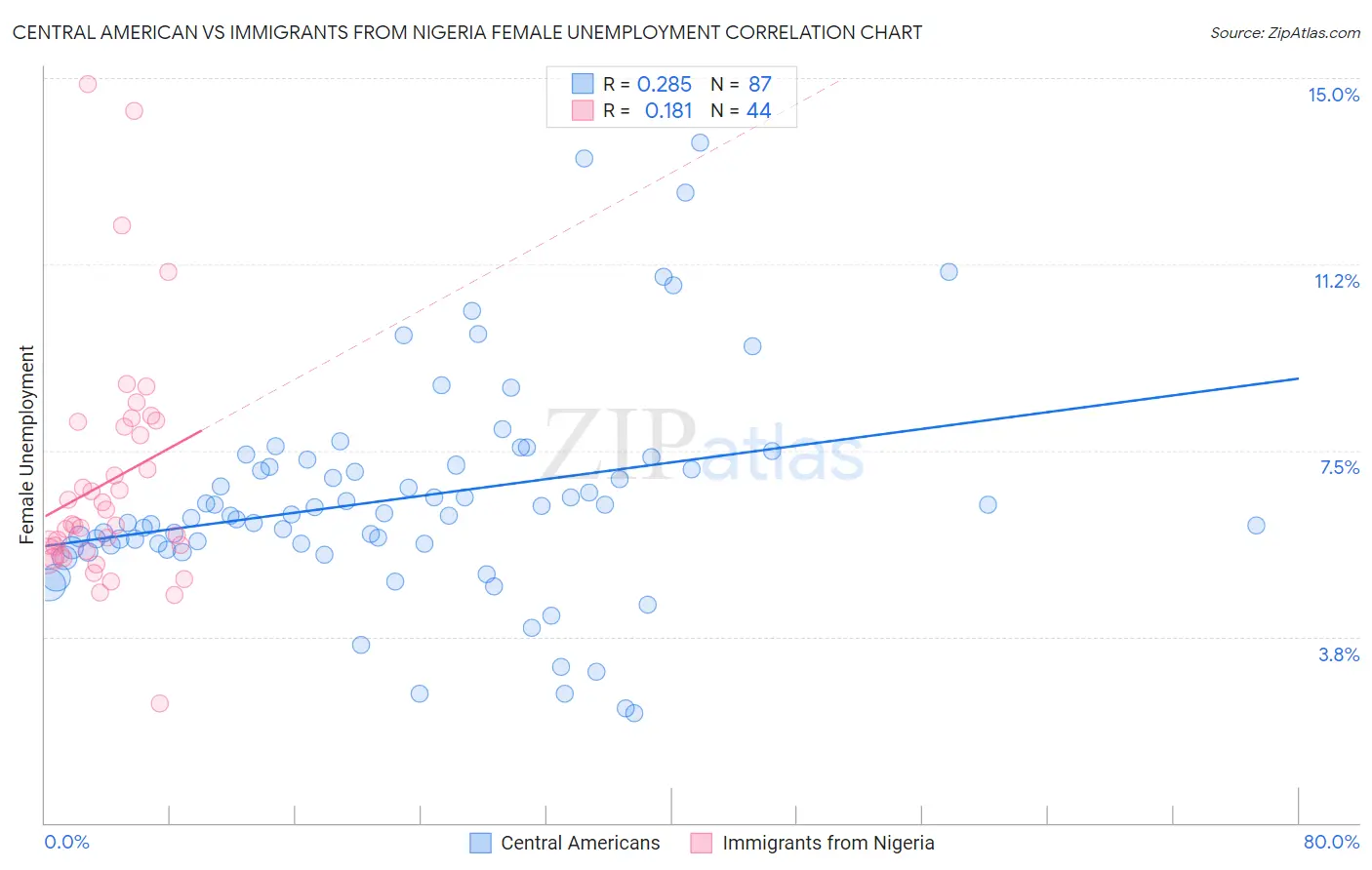Central American vs Immigrants from Nigeria Female Unemployment
COMPARE
Central American
Immigrants from Nigeria
Female Unemployment
Female Unemployment Comparison
Central Americans
Immigrants from Nigeria
5.9%
FEMALE UNEMPLOYMENT
0.0/ 100
METRIC RATING
271st/ 347
METRIC RANK
5.8%
FEMALE UNEMPLOYMENT
0.1/ 100
METRIC RATING
262nd/ 347
METRIC RANK
Central American vs Immigrants from Nigeria Female Unemployment Correlation Chart
The statistical analysis conducted on geographies consisting of 499,975,290 people shows a weak positive correlation between the proportion of Central Americans and unemploymnet rate among females in the United States with a correlation coefficient (R) of 0.285 and weighted average of 5.9%. Similarly, the statistical analysis conducted on geographies consisting of 283,043,160 people shows a poor positive correlation between the proportion of Immigrants from Nigeria and unemploymnet rate among females in the United States with a correlation coefficient (R) of 0.181 and weighted average of 5.8%, a difference of 2.7%.

Female Unemployment Correlation Summary
| Measurement | Central American | Immigrants from Nigeria |
| Minimum | 2.2% | 2.4% |
| Maximum | 13.7% | 14.9% |
| Range | 11.5% | 12.5% |
| Mean | 6.5% | 6.9% |
| Median | 6.2% | 6.0% |
| Interquartile 25% (IQ1) | 5.6% | 5.4% |
| Interquartile 75% (IQ3) | 7.2% | 8.0% |
| Interquartile Range (IQR) | 1.6% | 2.6% |
| Standard Deviation (Sample) | 2.2% | 2.4% |
| Standard Deviation (Population) | 2.2% | 2.4% |
Demographics Similar to Central Americans and Immigrants from Nigeria by Female Unemployment
In terms of female unemployment, the demographic groups most similar to Central Americans are Immigrants from Honduras (5.9%, a difference of 0.10%), Lumbee (5.9%, a difference of 0.19%), Ghanaian (5.9%, a difference of 0.20%), African (5.9%, a difference of 0.28%), and Immigrants from Western Africa (5.9%, a difference of 0.51%). Similarly, the demographic groups most similar to Immigrants from Nigeria are Kiowa (5.8%, a difference of 0.030%), Nigerian (5.8%, a difference of 0.30%), Immigrants from Fiji (5.8%, a difference of 0.33%), Immigrants from Portugal (5.8%, a difference of 0.44%), and Immigrants from the Azores (5.8%, a difference of 0.67%).
| Demographics | Rating | Rank | Female Unemployment |
| Sub-Saharan Africans | 0.4 /100 | #256 | Tragic 5.7% |
| Dutch West Indians | 0.3 /100 | #257 | Tragic 5.7% |
| Immigrants | Portugal | 0.2 /100 | #258 | Tragic 5.8% |
| Immigrants | Fiji | 0.2 /100 | #259 | Tragic 5.8% |
| Nigerians | 0.2 /100 | #260 | Tragic 5.8% |
| Kiowa | 0.1 /100 | #261 | Tragic 5.8% |
| Immigrants | Nigeria | 0.1 /100 | #262 | Tragic 5.8% |
| Immigrants | Azores | 0.1 /100 | #263 | Tragic 5.8% |
| Immigrants | Bahamas | 0.1 /100 | #264 | Tragic 5.8% |
| Blackfeet | 0.0 /100 | #265 | Tragic 5.9% |
| Cape Verdeans | 0.0 /100 | #266 | Tragic 5.9% |
| Nepalese | 0.0 /100 | #267 | Tragic 5.9% |
| Hondurans | 0.0 /100 | #268 | Tragic 5.9% |
| Immigrants | Western Africa | 0.0 /100 | #269 | Tragic 5.9% |
| Immigrants | Honduras | 0.0 /100 | #270 | Tragic 5.9% |
| Central Americans | 0.0 /100 | #271 | Tragic 5.9% |
| Lumbee | 0.0 /100 | #272 | Tragic 5.9% |
| Ghanaians | 0.0 /100 | #273 | Tragic 5.9% |
| Africans | 0.0 /100 | #274 | Tragic 5.9% |
| Senegalese | 0.0 /100 | #275 | Tragic 6.0% |
| Bahamians | 0.0 /100 | #276 | Tragic 6.0% |